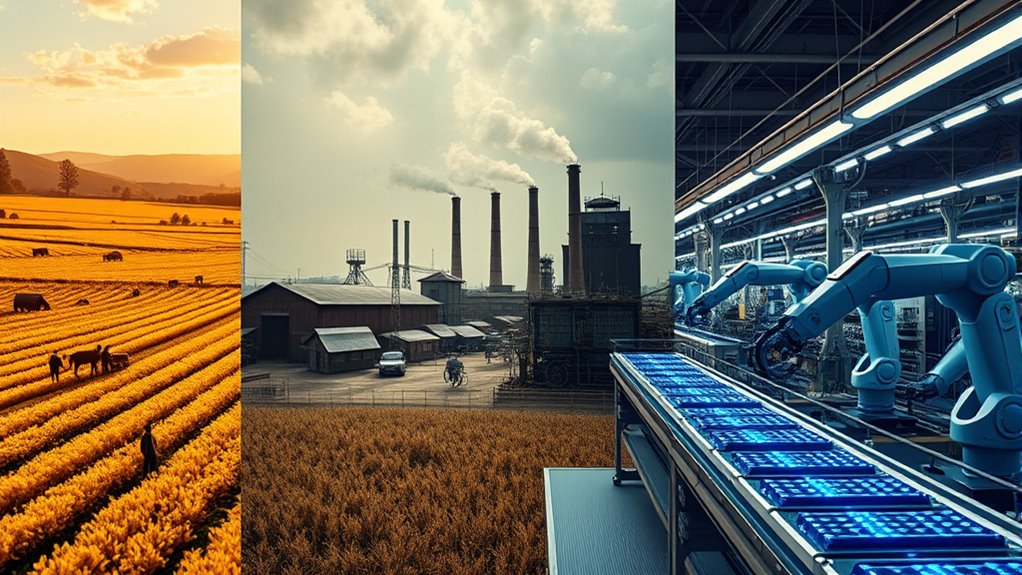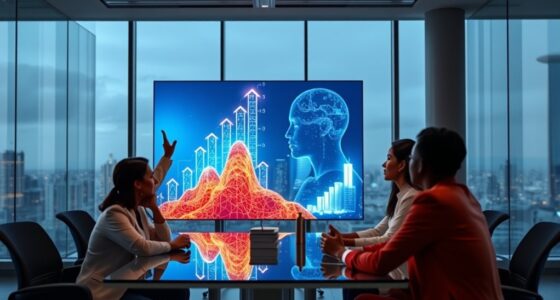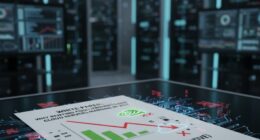Automation has dramatically transformed work, from early farming tools like seed drills to complex robots in factories. With each technological leap, tasks become faster and less labor-intensive, shaping industries and roles. As machines evolved into programmable robots and AI systems, they began to learn and adapt, reshaping how work is done across sectors. If you keep exploring, you’ll discover how these powerful changes are shaping the future of work worldwide.
Key Takeaways
- Early tools like forked sticks and mechanized seed drills marked the initial shift from manual labor to automation in agriculture.
- The Industrial Revolution introduced mechanized textiles, assembly lines, and steam power, transforming factory work and industrial productivity.
- The development of programmable robots and AI in the 20th century revolutionized manufacturing, enabling automation of complex tasks.
- Digital transformation and AI integration have further optimized industries, creating smarter, more adaptive work environments across sectors.
- The ongoing evolution from farm tools to intelligent systems continuously redefines work, emphasizing efficiency, innovation, and human-machine collaboration.
The Dawn of Mechanical Assistance in Agriculture

The dawn of mechanical assistance in agriculture marked a significant turning point in farming history. You’d find that the earliest tools, like forked sticks for plowing, date back to around 5500 BC. Over time, these simple wooden implements evolved into metal-bladed plows, boosting efficiency. For centuries, manual sowing and harvesting kept farming labor-intensive. Then, draft animals such as oxen and horses began to replace human effort for plowing and transport. Despite these changes, tools remained basic, relying mainly on animal power. It wasn’t until the 18th century that innovations like Jethro Tull’s seed drill emerged, mechanizing planting and reducing seed waste. The seed drill, invented in 1702, was one of the earliest mechanical planting devices, significantly increasing crop yields. These early developments set the stage for future advancements, gradually transforming agriculture from manual labor to mechanized processes and highlighting the importance of agricultural technology in this evolution. Additionally, the integration of mechanized equipment laid the groundwork for modern farming techniques, further revolutionizing the industry.
The Rise of Manufacturing Automation and Mass Production
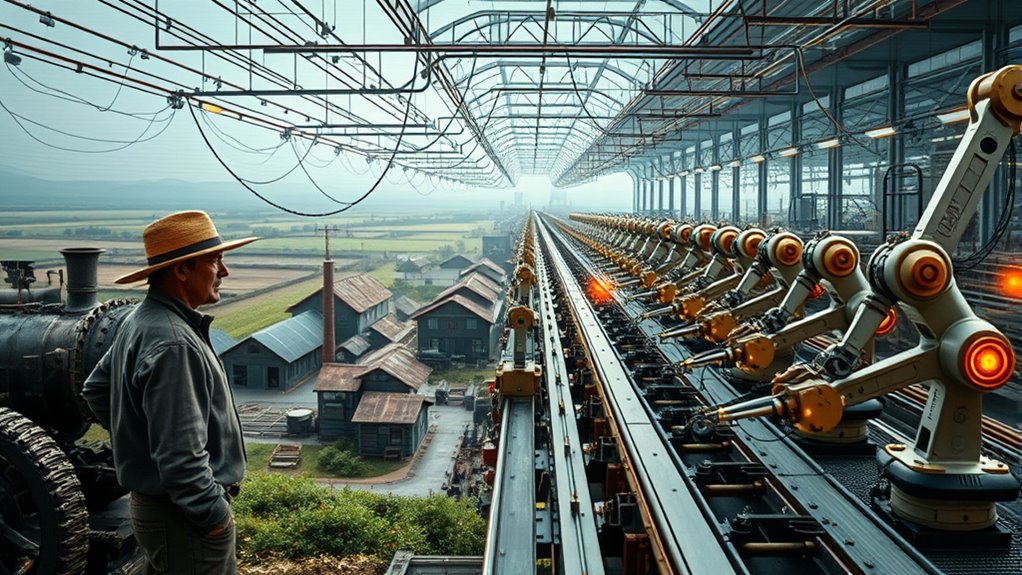
As the First Industrial Revolution gained momentum, innovations in machinery revolutionized manufacturing processes. The spinning jenny and power loom automated textile production, drastically increasing output. Steam engines and mechanized tools shifted manufacturing from manual labor to machine-driven processes, laying the foundation for mass production. This shift changed workforce dynamics, making some jobs obsolete but boosting overall productivity and economic growth. In the early 20th century, the introduction of assembly lines by pioneers like Henry Ford further transformed manufacturing, enabling faster, cheaper mass production. Electricity and expanded rail networks facilitated quicker transportation and communication. These advancements lowered costs, increased output, and fueled economic expansion—setting the stage for continuous automation and innovation in the decades to come. The development of assembly lines and electric power further accelerated manufacturing efficiency and production capacity, with technological advancements continuing to reshape industry practices. Additionally, the integration of Kia Tuning concepts into manufacturing processes has driven the development of more sophisticated automation tools, enhancing precision and reducing production times across various industries. Moreover, addressing common manufacturing failures through improved maintenance and installation practices has become essential for sustaining these technological gains. Furthermore, cybersecurity vulnerabilities during technological transitions underscore the importance of integrating cybersecurity practices into industrial systems to protect against potential threats.
The Emergence and Evolution of Industrial Robotics

You can see how mechanical origins laid the foundation for modern industrial robots, starting with early prototypes made from simple parts like Meccano. As technology advanced, innovations like programmable control systems and hydraulic actuators transformed robots into versatile tools for manufacturing. These technological leaps paved the way for the sophisticated, intelligent robots we see today across various industries. Data and connectivity have also played a crucial role in enhancing robot capabilities, enabling integration into comprehensive manufacturing ecosystems. Additionally, advancements in robotic sensors have improved precision and safety in automated processes. The integration of advanced control algorithms has further increased the adaptability and efficiency of modern robotic systems.
Mechanical Origins of Robots
Mechanical origins of robots trace back to automata from the Italian Renaissance, where inventors crafted intricate mechanical devices that could perform autonomous tasks. These early automata influenced the development of mechanical devices resembling robots, as innovators experimented with designs that operated independently. In 1937, “Bill” Griffith P. Taylor built the first known industrial robot using Meccano parts and a single electric motor. Unimation’s early robots were programmable transfer machines primarily used for moving objects, initially powered by hydraulic actuators. The shift to electric actuators in the 1970s, along with microprocessors, marked significant progress. Pioneers like Victor Scheinman created electrically actuated robots, enabling complex tasks. These innovations laid the foundation for the global expansion of industrial robotics and increased automation capabilities in manufacturing. The development of programmable controllers revolutionized industrial automation, allowing robots to perform a variety of tasks with increased precision and flexibility, and industry recognition as a key factor in provider selection further propelled their adoption. Additionally, advancements in electric actuators greatly enhanced the efficiency and versatility of robotic systems, making them indispensable in modern manufacturing. The integration of programmable controllers also contributed to the adaptability of robotic systems across diverse industries, expanding their role beyond traditional manufacturing. Moreover, the growing importance of AI and sensor integration is transforming robotic capabilities, enabling more autonomous and intelligent operations.
Technological Advances in Automation
How did industrial robotics evolve from simple automation tools to sophisticated systems capable of complex tasks? It all started with Richard Hohn’s 1960s minicomputer-controlled robots and George Devol’s 1954 patent for a programmable robotic arm. The first industrial robot, Unimate, was deployed in 1961 to perform repetitive, high-precision tasks like transferring parts. Over time, three key innovations shaped their evolution:
- Integration of microprocessors in the 1980s improved control and precision.
- Advancements in sensors and computer vision in the 1990s enabled robots to recognize environments and adapt.
- The incorporation of artificial intelligence and machine learning allowed robots to learn, make decisions, and work collaboratively with humans. The development of autonomous navigation and perception systems further enhanced robot functionality. Additionally, these technological improvements have contributed to increased accessibility of machine learning tools, allowing more industries to adopt advanced robotic solutions. These breakthroughs transformed robots from simple automata into versatile, intelligent systems across industries. Moreover, the integration of robotic intelligence has played a crucial role in enabling robots to perform increasingly complex and adaptive tasks. A deeper understanding of sensor integration also helped improve their responsiveness and accuracy. The ongoing development of adaptive algorithms continues to push the boundaries of what robots can achieve, making automation even more integral to modern manufacturing and beyond.
The Digital Revolution in Service and Information Sectors

You’re witnessing how digital tools are transforming service and information sectors, making processes faster and more efficient. E-commerce growth is reshaping consumer habits, while AI-powered innovations are enhancing customer experiences. This digital revolution is reshaping industries and creating new opportunities for businesses and workers alike. Digital transformation market projected to reach USD 3.9 trillion by 2027, highlighting the scale and rapid growth of this shift. Additionally, automation’s role in business intelligence is enabling real-time decision-making and predictive analytics, further accelerating industry evolution.
Digital Tools Transformation
Have you ever wondered how digital tools are reshaping the service and information sectors? The digital revolution is transforming industries rapidly. Here’s how:
- Market Growth: The digital transformation market is projected to grow at a CAGR of 23.6% through 2030, reaching over $3,375 billion. Worldwide digital transformation spending reached $1.85 trillion in 2022, a 16% increase from the previous year.
- Adoption Rates: About 70% of businesses are actively creating or implementing digital transformation plans, boosting efficiency and competitiveness.
- Sector Impact: In the information sector, data analytics and AI drive growth, creating new digital jobs and expanding digital exports.
These changes mean you’ll see more digital-first strategies, increased digital literacy, and a workforce that must adapt quickly. The digital tools revolution is fundamentally redefining how service and information sectors operate, shaping the future of work across industries.
E-commerce Expansion Growth
The rapid growth of digital tools has paved the way for e-commerce to become a dominant force in the service and information sectors. You’re part of a global shift, with nearly 28 million online stores and 2.77 billion shoppers worldwide, led by China and the US. By 2028, sales could reach almost $8 trillion, with Asia generating over two trillion dollars in 2024. Regional success varies, but growth continues steadily.
| Region | Key Metrics |
|---|---|
| Asia | $2 trillion+ in 2024 |
| US | $1.3 trillion in 2025, +8.6% in 2025 |
| Market Share | 22.6% by 2027 |
| Growth Rate | 8.02% CAGR globally (2025–2029) |
This expansion reshapes commerce, emphasizing the importance of technological integration and consumer behavior insights.
AI-Powered Service Innovation
AI-driven innovations are transforming service and information sectors at an unprecedented pace, enabling businesses to deliver faster, more personalized experiences. You’ll see how AI accelerates customer support, enhances data analysis, and revolutionizes decision-making.
- AI improves efficiency by handling 13.8% more inquiries per hour and boosts support quality by 1.3%.
- Nearly half of businesses (48%) leverage AI to harness big data, automating tasks to focus on complex challenges.
- AI-driven tools deliver an average performance increase of 66%, helping sectors like healthcare, finance, and cybersecurity make smarter decisions.
As companies prioritize AI, expect a surge in talent demand and ethical considerations around bias and data security. Early adopters gain a critical competitive edge, reshaping the service landscape for the future.
The Integration of Advanced Technologies in Modern Industries
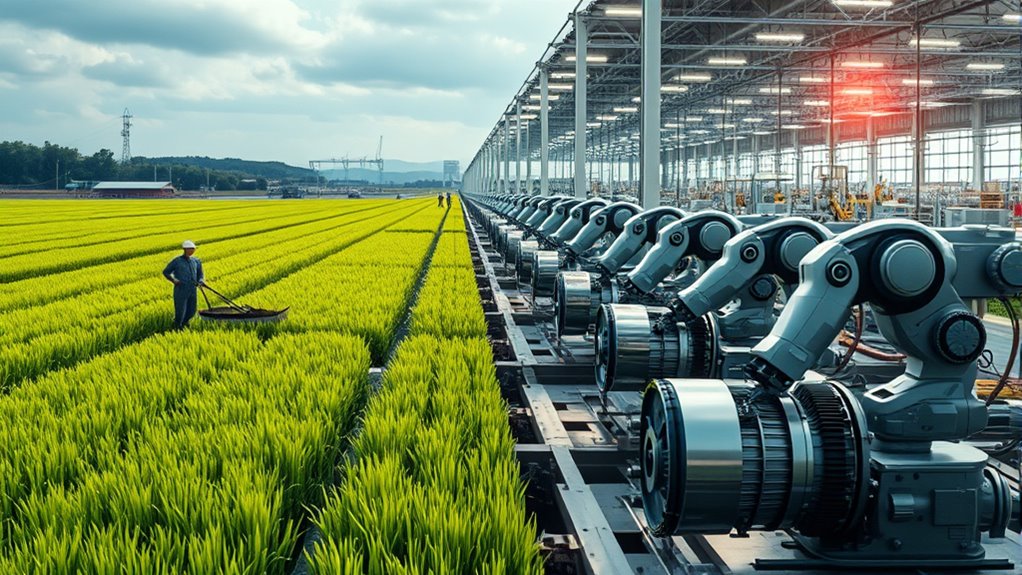
Modern industries are rapidly integrating advanced technologies to boost efficiency, agility, and competitiveness. You see, cloud and edge computing are now adopted by 48% of enterprises, enabling scalable data processing. Technologies like 5G are gaining traction, with a 37% adoption rate, ensuring faster, reliable connectivity. Over 70% of companies plan to use AI-driven tools by 2025, automating tasks and improving decision-making. Generative AI is also emerging, though only half plan adoption by then. Industry 4.0 combines AI, IoT, and cloud computing to transform manufacturing. Here’s a quick overview:
| Technology | Adoption Rate | Key Benefits |
|---|---|---|
| Cloud & Edge Computing | 48% | Scalable data processing |
| 5G Connectivity | 37% | Faster, reliable data transfer |
| AI Integration | 70%+ | Automates tasks, enhances decisions |
Opportunities and Challenges in the Age of Autonomous Systems

Autonomous systems are transforming industries by offering new opportunities for increased efficiency, safety, and market growth. You can automate repetitive tasks, allowing 24/7 operations that boost productivity. They also improve quality—like BMW’s humanoid robots reducing errors—and enhance safety by enabling drones to handle risky inspections. However, challenges remain. You’ll face:
- Integration issues with existing infrastructure
- Data management complexities from handling vast information
- Regulatory hurdles for developing and enforcing standards
While these systems unbolt significant potential, they also pose risks like job displacement and technical hurdles in training and implementation. Balancing these opportunities and challenges is key to shaping a resilient, innovative future across industries.
Envisioning the Future: AI, IoT, and the Next Wave of Automation
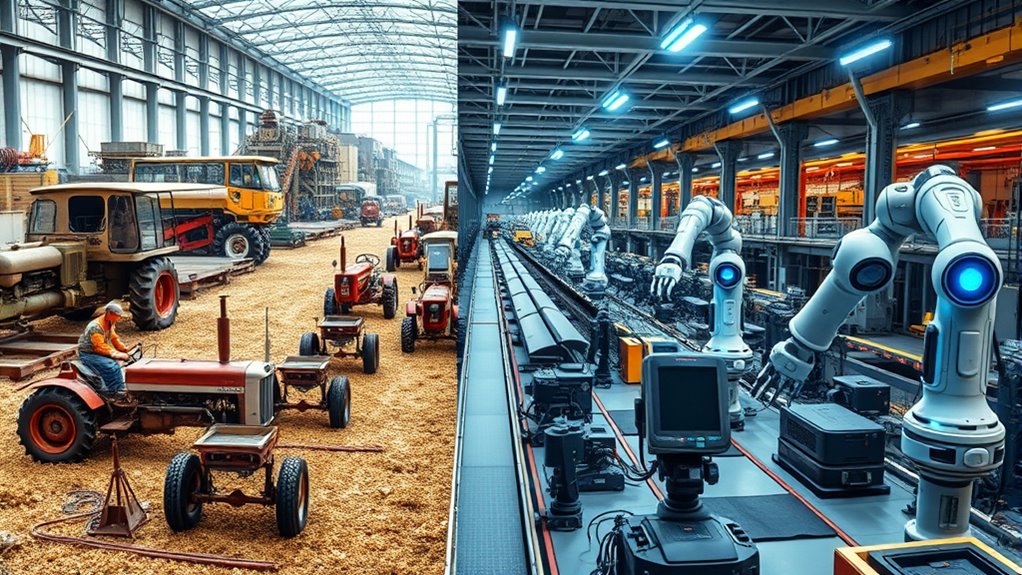
As industries embrace digital transformation, AI, IoT, and automation are converging to reshape how businesses operate. You’ll see AI prioritized, with 83% of companies making it a top focus by 2025. The AI workforce will grow to 97 million, fueling innovation and efficiency. Investments in AI soar, with 92% planning to increase spending. In manufacturing, AI’s market hits $8.57 billion, and over 60% of new products will use generative AI by 2025. IoT’s role expands, dominating 72% of market revenue by 2028, enabling real-time data and smarter decisions. This convergence leads to flexible, resilient systems that optimize energy, maintenance, and productivity. Here’s a deeper look:
| AI & IoT Impact | Business Benefits |
|---|---|
| Smarter, connected systems | Increased efficiency and resilience |
| Real-time data use | Better decision-making and adaptability |
Frequently Asked Questions
How Did Early Automation Impact Rural Farming Communities?
Early automation impacted rural farming communities by increasing productivity and reducing manual labor, which meant fewer workers were needed. You might have seen jobs shift from traditional hands-on tasks to operating machines, leading to job displacement. While some farmers benefited from higher yields and efficiency, others faced economic struggles and social changes, as communities adapted to technological advances that transformed farming from a labor-intensive activity into a more automated, capital-driven industry.
What Are the Key Differences Between Mechanical and Electronic Automation?
Mechanical and electronic automation differ distinctly. Mechanical automation relies on physical parts like gears, pistons, and pneumatic or hydraulic systems to perform tasks, often offering reliability and affordability. Electronic automation, however, employs sensors, digital signals, and software to control and customize processes with precision and speed. While mechanical systems are simpler, electronic systems are smarter, more flexible, and capable of complex, quick responses, transforming industries in powerful, progressive ways.
How Do Robotics Influence Employment in Manufacturing Industries?
Robotics influence manufacturing employment by replacing repetitive tasks, which can lead to job reductions, especially for less-skilled workers. You might see wages decline and employment drop in regions with high robot density. However, robots also create opportunities by shifting demand toward more technical roles. As a worker, you’ll need to adapt by upskilling, since automation can displace some jobs but also fosters new, complex job sectors.
What Role Does AI Play in Transforming Service Industries Today?
You’ll find that AI is revolutionizing service industries, with 56% already using AI-powered support to boost efficiency. It personalizes customer experiences, automates repetitive tasks, and provides 24/7 support, which improves satisfaction and cuts costs. As AI adoption grows worldwide, especially in banking and customer service, you’ll see markedly faster, more tailored services. This shift not only enhances customer happiness but also reshapes job roles and operational strategies.
How Can Future Automation Balance Innovation With Cybersecurity Risks?
You need to balance innovation with cybersecurity risks by adopting proactive strategies. Implement zero-trust models, regularly monitor endpoints, and train staff to recognize threats. Partner with security vendors for expert support, and automate security functions with AI for faster threat detection. Modernize legacy systems and guarantee regulatory compliance. By staying vigilant and embracing secure technologies, you can reap automation’s benefits while safeguarding your systems against evolving cyber threats.
Conclusion
Just as the phoenix rises from its ashes, your future work life will be reborn through AI and automation. Embrace these changes, for they’re shaping a new era—one where human ingenuity partners with technology. Like Icarus reaching for the sun, don’t fear the heights of innovation; instead, soar with it. Your role in this ongoing story is essential. Together, you can create a future where work and progress shine brighter than ever before.
